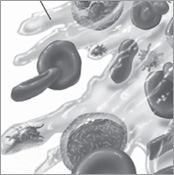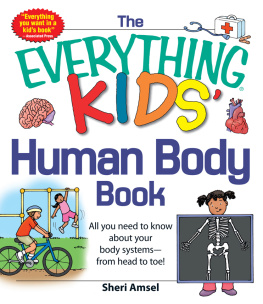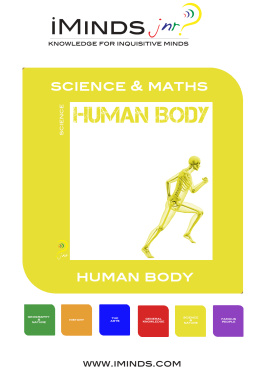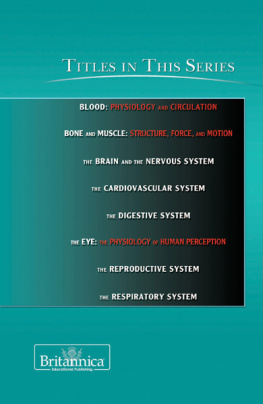BLOOD
PHYSIOLOGY AND CIRCULATION
THE HUMAN BODY
BLOOD
PHYSIOLOGY AND CIRCULATION
EDITED BY KARA ROGERS, SENIOR EDITOR, BIOMEDICAL SCIENCES

Published in 2011 by Britannica Educational Publishing
(a trademark of Encyclopdia Britannica, Inc.)
in association with Rosen Educational Services, LLC
29 East 21st Street, New York, NY 10010.
Copyright 2011 Encyclopdia Britannica, Inc. Britannica, Encyclopdia Britannica, and the Thistle logo are registered trademarks of Encyclopdia Britannica, Inc. All rights reserved.
Rosen Educational Services materials copyright 2011 Rosen Educational Services, LLC. All rights reserved.
Distributed exclusively by Rosen Educational Services.
For a listing of additional Britannica Educational Publishing titles, call toll free (800) 237-9932.
First Edition
Britannica Educational Publishing
Michael I. Levy: Executive Editor
J.E. Luebering: Senior Manager
Marilyn L. Barton: Senior Coordinator, Production Control
Steven Bosco: Director, Editorial Technologies
Lisa S. Braucher: Senior Producer and Data Editor
Yvette Charboneau: Senior Copy Editor
Kathy Nakamura: Manager, Media Acquisition
Kara Rogers: Senior Editor, Biomedical Sciences
Rosen Educational Services
Jeanne Nagle: Senior Editor
Heather M. Moore Niver: Editor
Nelson S: Art Director
Cindy Reiman: Photography Manager
Matthew Cauli: Designer, Cover Design
Introduction by Don Rauf
Library of Congress Cataloging-in-Publication Data
Blood: physiology and circulation / edited by Kara Rogers.
p. cm.(The human body)
In association with Britannica Educational Publishing, Rosen Educational Services.
Includes bibliographical references and index.
ISBN 978-1-61530-250-5 (eBook)
1. BloodPopular works. 2. BloodCirculationPopular works. I. Rogers, Kara.
QP91.B6558 2010
612.115dc22
2010000145
On the cover: Blood courses though the body, circulating vital oxygen and nutrients. www.istockphoto.com/Mads Abildgaard
On page : A medical attendant collects donations during a blood drive. Joel Nito/AFP/Getty Images
Pages www.istockphoto.com/Sebastian Kaulitzki
CONTENTS















INTRODUCTION

H umans have been fascinated by the intricacies of blood as far back as early Egyptian civilization. Tombs in Egypt depicted bloodlettinga procedure through which blood is intentionally removed from a veinas a treatment for sick patients. Some ancient Greeks drank the blood of a fallen warrior, believing that by doing so they would gain the dead mans strength and courage. Misunderstandings persisted for centuries. For instance, medical professionals still erroneously believed that bloodletting was the cure for a number of maladies well into the Common Era. It wasnt until 1628, when British physician William Harvey published his finding on how blood was pumped from the heart throughout the body and then recirculated, that the widespread practice of draining a persons blood was called into question.
A proper and thorough understanding of bloods function took thousands of years to develop. Throughout the 20th century and into the 21st, methods of examining, storing, and using blood were improved in order to more effectively fight disease and save lives. Indeed, the understanding of how blood works in the body has come a long way, as elucidated in this volume. Readers will discover virtually everything science has learned about blood, from its basic properties to its circulation through the body to its malfunction in disease.
Blood has numerous functions in a healthy body. One of its primary tasks is to deliver oxygen and nutrients to the bodys cells. Blood also distributes warmth to those regions that need it the most, wards off disease, and helps to filter harmful waste products such as carbon dioxide out of the body.
The various components of blood each play a role. In humans, blood cells are produced by stem cells in the bone marrow. Once these cells develop, they are released into the bloodstream. Red blood cells deliver hemoglobin, which is the iron-bearing protein that makes the transportation of oxygen possible. Hemoglobin also gives human blood, and that of many other animals, its red colour. Certain creatures have different oxygen-carrying pigments, such as hemocyanin or chlorocruorin. When oxygenated, these pigments turn blood various colours; for example, blood is blue when the copper-rich hemocyanin is present, and it is green when chlorocruorin is present. The existence of different types of blood pigments explains why crustaceans such as lobsters have blue blood.
Also known as erythrocytes, red blood cells make up about 45 percent of blood. The liquid portion of the blood, plasma, makes up about 54 percent of bloods content. Although 90 percent water, plasma contains elements that are essential for sustaining health and life, including critical proteins. The remaining 1 percent of bloods composition is made up of white blood cells (leukocytes) and platelets (thrombocytes). White blood cells help protect the body from infections and disease by destroying the agents that cause illness. White blood cells are further categorized as lymphocytes, which help the bodys immunity, and phagocytic cells (both granulocytes and monocytes), which ingest and break down microorganisms and foreign particles. The tiny fragments called platelets are important in the formation of blood clots (coagulation).
Next page
































